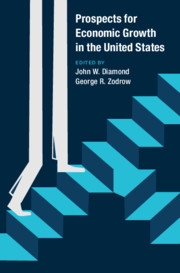Book contents
- Prospects for Economic Growth in the United States
- Prospects for Economic Growth in the United States
- Copyright page
- Dedication
- Contents
- Figures
- Tables
- Notes on Contributors
- Foreword
- Preface
- Acknowledgments
- Part I Overview
- 1 Introduction
- 2 The Future of Economic Growth in the United States
- Part II Labor and Economic Growth
- Part III Implications of Technology for Growth
- Part IV The Effects of Fiscal Policy on Growth
- Part V Special Topics on Economic Growth
- Part VI A Concluding Perspective
- Index
- References
1 - Introduction
from Part I - Overview
Published online by Cambridge University Press: 21 October 2021
- Prospects for Economic Growth in the United States
- Prospects for Economic Growth in the United States
- Copyright page
- Dedication
- Contents
- Figures
- Tables
- Notes on Contributors
- Foreword
- Preface
- Acknowledgments
- Part I Overview
- 1 Introduction
- 2 The Future of Economic Growth in the United States
- Part II Labor and Economic Growth
- Part III Implications of Technology for Growth
- Part IV The Effects of Fiscal Policy on Growth
- Part V Special Topics on Economic Growth
- Part VI A Concluding Perspective
- Index
- References
Summary
This introduction summarizes the nine central chapters that make up this volume. Martin Feldstein examines the structural reasons for relatively high US growth rates, notes fiscal problems inhibiting future growth including in deficits in social insurance programs, and suggests reforms. Flávio Cunha examines how the development of human capital, especially at early ages, affects economic growth. George Borjas analyzes how increased immigration would affect economic growth in the United States. Glenn Hubbard explores the debate between “techno-optimists” and “techno-pessimists” on the growth effects of technological progress, while Timothy Bresnahan examines in detail the commercial applications of Artificial Intelligence Technologies (AITs). Robert Barro estimates the macroeconomic effects of the recently enacted Tax Cuts and Jobs Act, while John Diamond and George Zodrow examine the macroeconomic and distributional effects of a carbon tax. Ross Levine discusses the links between banking and economic prosperity, and Stephen Turnovsky examines the relationships among income, wealth inequality, and economic growth.
Keywords
- Type
- Chapter
- Information
- Prospects for Economic Growth in the United States , pp. 3 - 21Publisher: Cambridge University PressPrint publication year: 2021

